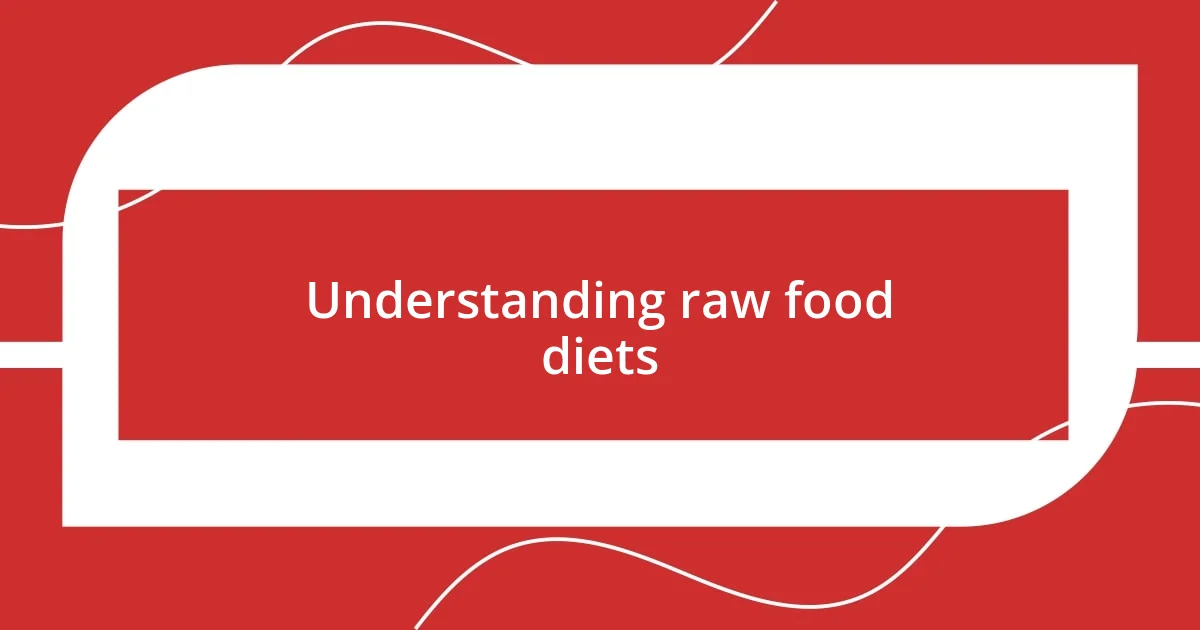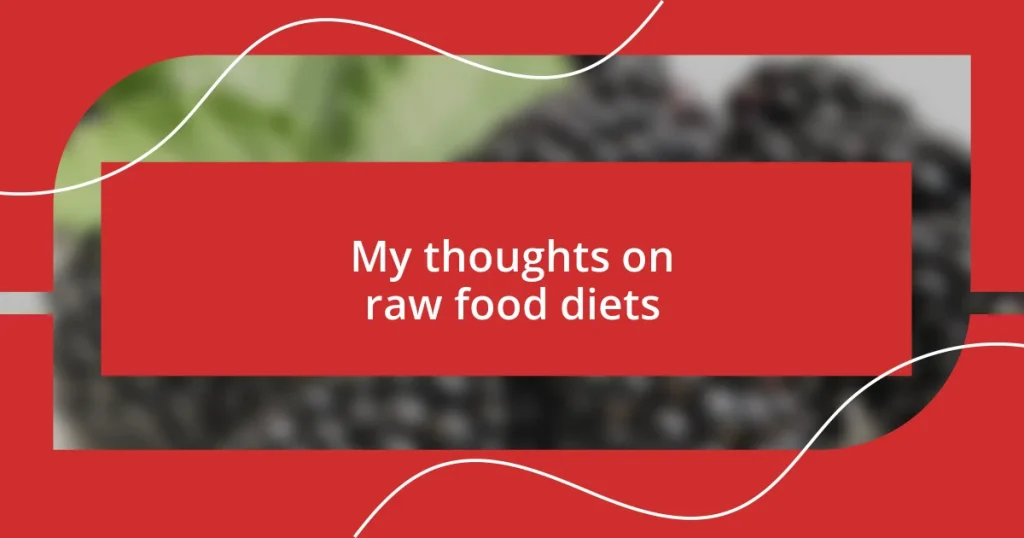Key takeaways:
- Raw food diets focus on uncooked, unprocessed foods, preserving vital nutrients and offering diverse flavors and culinary creativity.
- Key benefits include increased energy, enhanced fiber intake promoting digestion, and encouraging mindfulness in eating.
- Common misconceptions about raw diets include the belief that they are limited in flavor and variety, as well as overlooking nutritional balance, particularly for vitamins like B12 and iron.

Understanding raw food diets
Raw food diets primarily consist of uncooked, unprocessed foods. The philosophy is rooted in the belief that heating food above about 118 degrees Fahrenheit (48 degrees Celsius) destroys essential nutrients and enzymes. From my experience, I’ve found that trying a raw food diet can feel like peeling back layers of flavor and texture that you might not appreciate in cooked foods.
I remember the first time I bit into a fresh, raw zucchini tossed in a simple lemon dressing. It was surprisingly refreshing! In that moment, I was surprised by how vibrant raw vegetables can be, often bursting with flavors I had previously missed when sautéing them. Eating raw can be a thrilling exploration of taste, but it does require a shift in mindset—are we ready to embrace this new way of enjoying food?
The raw food diet can seem restrictive at first glance, but it offers incredible diversity and creativity. Have you ever made a raw dessert, like a cacao avocado mousse? It’s truly a game changer! I found that experimenting with ingredients and recipe combinations took my culinary skills to a new level, and it’s exciting to see how nourishing and satisfying raw meals can be.

Benefits of raw food diets
Raw food diets come with a range of benefits that can be quite transformative. One key advantage is the preservation of vitamins and minerals that can be lost through cooking. When I switched to incorporating more raw vegetables, I noticed how my energy levels surged. Just eating a simple salad comprised of kale, bell peppers, and tomatoes left me feeling rejuvenated and ready to tackle my day.
Another significant benefit is the natural increase in fiber intake. Raw foods, particularly fruits and vegetables, are packed with dietary fiber, which promotes good digestion. I can recall feeling lighter and more balanced after meals when I focused on raw food options. Each bite felt full of life, and I could sense the positive impact on my gut health.
Finally, raw food diets encourage mindfulness in eating. Preparing and eating these foods often requires a slower approach, allowing us to savor the flavors and textures. I remember spending a whole weekend experimenting with different raw sauces and dips. It transformed mealtime from a hurried affair into a joyful exploration, which deepened my appreciation for the food I consumed.
| Benefit | Description |
|---|---|
| Preserved Nutrients | Maintains essential vitamins and minerals lost in cooking. |
| Increased Fiber | Boosts digestion and promotes gut health. |
| Mindfulness in Eating | Encourages slower meals and appreciation for food. |

Common misconceptions about raw food
Many people assume that a raw food diet is just about salads and smoothie bowls. While those are staples, it’s a vibrant world of creativity and diverse flavors. I remember my own surprise when I stumbled upon raw vegan sushi made with zucchini noodles instead of rice. Who knew raw ingredients could be so versatile?
Here are some misconceptions that deserve a spotlight:
- Raw Foods Are Flavorless: Many believe that raw diets lack depth and taste, but that’s far from the truth. Experimenting with herbs and spices can elevate any dish.
- Only Vegetables and Fruits Are Allowed: It’s often misunderstood that proteins and fats have to be excluded. Nuts, seeds, and even certain plant-based cheeses can easily fit in.
- Nutrient Loss Is Absolute: There’s a belief that cooking always depletes nutrients; however, some foods like tomatoes actually have more of certain antioxidants when cooked lightly.
Just think about that time I paired a flavorful homemade raw pesto with spiralized veggies. It was a revelation! That combination showed me how raw can be just as satisfying as cooked, challenging those outdated assumptions.

Nutritional considerations for raw food
When considering a raw food diet, it’s essential to think about nutrient balance. I’ve seen how easy it can be to overlook certain vitamins when sticking solely to raw fruits and vegetables. For instance, iron and vitamin B12 often need a bit more attention, traditionally found in animal products. When I first started, I made a point to incorporate nuts and seeds, which not only provided protein but also delivered crucial minerals that might otherwise be missed.
Another important aspect is the potential for digestive challenges. While my gut felt lighter, I initially faced some discomfort as my system adjusted to the higher fiber intake. Have you ever experienced that? It took a short phase of consistency before I truly embraced how the raw foods were working for me. Gradually, my body adapted, and I started to appreciate how smart food choices could lead to improved digestion and energy levels over time.
Additionally, being mindful of food allergies and sensitivities becomes vital on a raw diet. I remember a friend who was excited to dive into this lifestyle, but she soon realized that some raw foods triggered her sensitivities. Recognizing my own reactions to certain raw items, like cucumbers, helped me tailor my intake, ensuring I felt my best. It’s crucial to listen to your body and adjust, as everyone’s experience can be unique on this journey.

Recipes for raw food meals
Creating delicious raw food meals can be an exciting adventure! One of my favorites is a vibrant raw taco salad, featuring a walnut and sunflower seed “meat” seasoned with cumin and chili powder. I love how the textures play together—the crunch of fresh veggies, the creaminess of avocado, and the zesty kick of lime really bring it to life. Have you ever tried layering flavors like that? It’s a beautiful way to transform simple ingredients into a feast for your taste buds.
Another gem in my raw recipe collection is the chocolate avocado mousse. It might sound a bit unconventional, but blending ripe avocados with raw cacao powder and a touch of maple syrup creates a rich, silky dessert that’s hard to resist. I still remember the first time I shared this with friends; their surprised faces were priceless! It’s moments like these that remind me how satisfying it is to showcase the versatility of raw ingredients.
For a refreshing twist, I often whip up raw zucchini pasta drizzled with a basil cashew cream sauce. It’s so simple yet incredibly satisfying. I’ll never forget the thrill of pretending I was indulging in a guilty pleasure, only to realize I was nourishing my body instead. Have you ever discovered a dish that completely changed how you viewed raw food? It really opens the door to endless culinary creativity!













